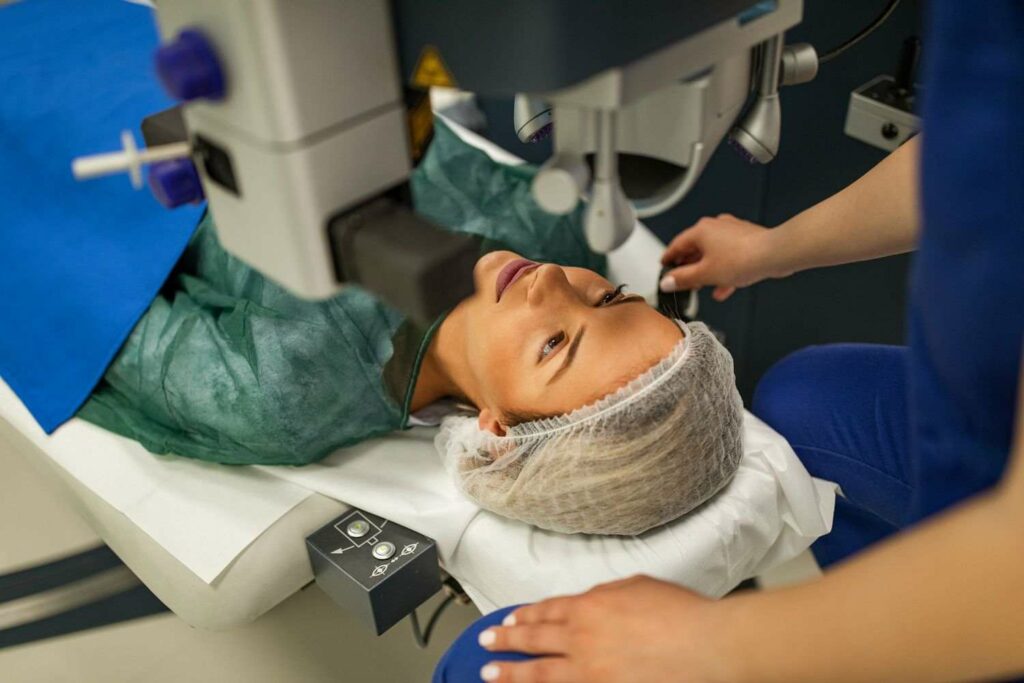For those with vision problems, corrective eyewear like glasses and contact lenses have been the traditional solution. However, advancements in medical technology have led to alternative options like LASIK (Laser-Assisted In Situ Keratomileusis) surgery. This procedure has become increasingly popular due to its effectiveness in correcting vision problems, making it an attractive option for those looking for a permanent solution. In this blog, we will explore the ins & outs of LASIK surgery, including its complete procedure, things to consider before, and follow-up tips. We will also discuss if this procedure is painful or not, & how long does it take to complete.
Contents
What Is LASIK?
 LASIK (Laser-Assisted In Situ Keratomileusis) is a type of refractive surgery used to correct vision problems like nearsightedness, farsightedness, & astigmatism. It uses a laser to reshape the cornea, which in turn helps in improving the eye’s ability to focus light & allowing for clearer vision. LASIK surgery is a popular & effective option for those seeking a permanent solution to vision problems & has helped millions of people around the world achieve improved vision without the need for corrective eyewear.
LASIK (Laser-Assisted In Situ Keratomileusis) is a type of refractive surgery used to correct vision problems like nearsightedness, farsightedness, & astigmatism. It uses a laser to reshape the cornea, which in turn helps in improving the eye’s ability to focus light & allowing for clearer vision. LASIK surgery is a popular & effective option for those seeking a permanent solution to vision problems & has helped millions of people around the world achieve improved vision without the need for corrective eyewear.
Procedure Of LASIK Surgery
Given below is a step-by-step procedure of LASIK surgery:
1. Anesthetic
Before the LASIK procedure, the eye is numbed with eye drops to prevent any discomfort or pain. The eye drops may cause a mild burning or stinging sensation, but this generally subsides quickly. In some cases, the surgeon may also administer a mild sedative to help the patient relax.
2. Flap
The surgeon creates a thin flap in the cornea using either a microkeratome or a femtosecond laser. The microkeratome is a hand-held instrument that uses a metal blade to create the flap, while the femtosecond laser uses a high-energy laser to create a precise & consistent flap. The flap is then lifted and folded back to expose the underlying cornea.
3. Reshaping
The surgeon then uses an excimer laser to remove tiny amounts of corneal tissue. The excimer laser uses a cool beam of light to precisely reshape the cornea according to the patient’s prescription. The surgeon will have previously determined the amount of corneal tissue that needs to be removed based on the patient’s eye measurements & the desired outcome of the surgery.
4. Replacement
Once the cornea has been reshaped, the surgeon carefully repositions the flap back onto the eye. The flap will naturally adhere to the underlying cornea without the need for stitches. The surgeon will then smooth out any wrinkles or air bubbles under the flap to ensure a smooth & even surface.
5. Recovery
After the LASIK procedure, your surgeon will cover the eye with a protective shield to prevent accidental rubbing or scratching. The patient will need to avoid rubbing their eyes, swimming, or any other activity that may put pressure on the eyes. The surgeon will provide specific postoperative care instructions, such as using eye drops to prevent infection & dryness and attending follow-up appointments to monitor the healing process. It may take a few days for the eye to fully heal, during which the patient may experience some blurry or hazy vision. However, most patients notice an immediate improvement in their vision after the surgery.
Is LASIK Procedure Painful?
LASIK is generally not a painful procedure. This is because the eye gets numb due to anesthetic eye drops before the surgery. During the procedure, patients may feel slight pressure or discomfort, but this is usually minimal & brief. Some patients may also experience a sensation of burning or a mild stinging during the procedure, but this typically subsides quickly.
After the surgery, some patients may experience mild discomfort or a gritty sensation in the eye. However, this can usually be managed with over-the-counter pain medication & typically subsides within a few days. The use of lubricating eye drops can also help alleviate any dryness or discomfort.
Overall, LASIK is a well-tolerated procedure, & most patients experience little to no pain during or after the surgery. However, every patient’s experience is unique, & it’s important to discuss any concerns or questions about the procedure with your eye surgeon.
How Long Does It Take To Complete The LASIK Procedure?
 The LASIK (Laser-Assisted In Situ Keratomileusis) procedure is a relatively quick surgery, typically taking only about 10 to 15 minutes per eye. However, the total time required for the procedure may vary depending on several factors, including the complexity of the patient’s prescription & any other unique characteristics of the patient’s eyes.
The LASIK (Laser-Assisted In Situ Keratomileusis) procedure is a relatively quick surgery, typically taking only about 10 to 15 minutes per eye. However, the total time required for the procedure may vary depending on several factors, including the complexity of the patient’s prescription & any other unique characteristics of the patient’s eyes.
Before the surgery, the patient will need to undergo a comprehensive eye examination to determine the exact amount of corneal tissue that needs to be removed. This process may take up to an hour or more, depending on the complexity of the prescription & the patient’s eye measurements.
During the LASIK procedure, the surgeon will create a thin flap in the cornea using a microkeratome or femtosecond laser, & then use an excimer laser to reshape the cornea. The entire procedure typically takes only a few minutes per eye.
After the surgery, the patient will need to rest for a short period & undergo a brief postoperative examination before leaving the surgical center. In most cases, the patient can return home the same day as the surgery and resume normal activities within a few days, although it may take several weeks for the eye to fully heal.
Things To Consider Before the LASIK Procedure
 Before undergoing LASIK (Laser-Assisted In Situ Keratomileusis) surgery, there are several important considerations that patients should take into account, including:
Before undergoing LASIK (Laser-Assisted In Situ Keratomileusis) surgery, there are several important considerations that patients should take into account, including:
- Age: LASIK is for patients over the age of 18, as younger patients may experience changes in their vision that could affect the outcome of the surgery.
- Eye health: Patients with certain eye conditions, such as severe dry eye syndrome, glaucoma, or cataracts, may not be good candidates for LASIK. It’s important to undergo a comprehensive eye examination to determine if you are a good candidate for the surgery.
- Pregnancy & breastfeeding: Women who are pregnant or breastfeeding should delay LASIK surgery, as hormonal changes during pregnancy & breastfeeding can affect the stability of the cornea.
- Cost: LASIK can be expensive, & not all insurance plans cover the procedure. Patients should carefully consider the cost of the surgery & explore financing options before undergoing LASIK.
- Other medical conditions: Patients with certain medical conditions, such as allergies, diabetes, or high blood pressure, must consider their medical condition. These can affect the healing process & increase the risk of complications. It’s important to inform the surgeon about any underlying medical conditions before undergoing LASIK. The surgeon can evaluate your overall health and help determine if LASIK is a safe and appropriate option for you.
It’s important to discuss these & any other relevant considerations with a qualified eye surgeon to determine if LASIK is a good option for you.
Follow Up Self Care Tips After LASIK Surgery
 Following LASIK (Laser-Assisted In Situ Keratomileusis) surgery, patients need to take special care of their eyes to ensure a smooth & successful recovery. Here are some follow-up self-care tips to help promote healing & prevent complications:
Following LASIK (Laser-Assisted In Situ Keratomileusis) surgery, patients need to take special care of their eyes to ensure a smooth & successful recovery. Here are some follow-up self-care tips to help promote healing & prevent complications:
- Follow all postoperative instructions from the surgeon. Use prescribed eye drops as directed & avoid activities like swimming, hot tubs, and contact sports.
- Wear eye protection, such as sunglasses, when outdoors or in bright light to avoid irritating the eyes.
- Avoid rubbing or touching the eyes, which can disrupt the healing process & increase the risk of infection.
- Avoid wearing eye makeup or applying creams or lotions near the eyes until instructed by the surgeon.
- Keep the eyes clean & dry, & avoid exposing them to dust or other airborne irritants.
- Attend all scheduled follow-up appointments with the surgeon to monitor the healing process & ensure that the vision is stable & clear.
By following these self-care tips and closely monitoring the healing process, patients can help ensure the best possible outcome from their LASIK surgery & enjoy clear, improved vision for years to come.
Conclusion
LASIK (Laser-Assisted In Situ Keratomileusis) surgery is a popular & effective procedure for correcting vision problems. Although the surgery is relatively safe & straightforward, it’s important for patients to carefully consider the potential risks and benefits before undergoing the procedure. By discussing any concerns with a qualified eye surgeon and carefully following postoperative instructions, patients can improve their chances of a successful outcome. If you are considering LASIK surgery, seek the help of a qualified eye surgeon to determine if the procedure is right for you.
Lasik surgery is a safe 10 minute procedure to help you get rid of glasses. EyeMantra offers the most advanced lasik options including PRK, Femto Lasik, SMILE surgery, Standard lasik, ICL and Contoura vision. If you have any questions on Lasik surgery in Delhi, Lasik surgery cost and Lasik procedure, call us at 9711116605 or email at [email protected].


